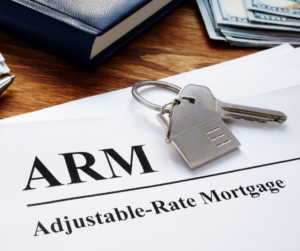When it comes to choosing a mortgage plan, most cases will have the option of a fixed rate for the life of the loan or allowing it to fluctuate up and down. An adjustable-rate mortgage is a home loan that starts as a fixed rate for a certain period and will fluctuate periodically depending on a benchmark’s performance. An ARM is made up of four components, an index, a margin, an interest rate cap structure, and an initial interest rate period.
The index is the benchmark interest rate that fluctuates based on the market. The margin is the percentage points in an interest rate added to the index and that’s what makes up the interest rate. An interest rate cap structure is what limits the rise in interest and keeps it from continuously going up. The initial interest rate period is a set period on a loan and includes an introductory interest rate that is lower than the remainder of the loan.
ARMs tend to be more appealing due to their lower initial interest rate. With the increase in 30-year fixed-rate mortgages hitting in high interest rate times, adjustable-rate mortgages may be more attractive to borrowers. There are three types of ARMs that are often selected from; Hybrid, Interest-only, and Payment-option.
Hybrid
Hybrid allows for a mix of a fixed and adjustable rate, where there is a predetermined time for when the rates will be fixed and adjustable. Take a 5/1 ARM, for example, this would allow for 5 years of a fixed rate and then would be followed by a variable rate that adjusts every year for the next 25 years. The same goes for 3/1 ARMs, 5/1 ARMs, 7/1 ARMs, and 10/1 ARMs with their respective numbers. What are the pros and cons?
Pros:
- Lower interest rates in the fixed-rate phase
- More flexibility if there are plans to move/sell the house or refinance
- Interest rates may decrease outside of the fixed-rate phase
- Limits on how much rates and payments can go up
Cons:
- Unpredictability about the rise and fall of interest rates
- Payments could increase
- Complicated rules and structures
Interest-Only (I-O)
Interest-only ARM is a loan in which only the interest is required to be paid for a certain period. After that certain time, both interest and principal are required to be paid back on the loan. I-O payments often last between 3-10 years, and after that, the monthly payment would increase as you are paying back the principal and interest.
Payment-Option (P-O)
A payment-option ARM allows for several payment options for the borrower. The options include traditional payments, interest-only payments, and minimum payments. Minimum payments are calculated based on the initial temporary starting interest rate and is what is paid in the beginning. Whatever is not paid in the beginning gets added onto the principal after.
Mortgage rates in 2022 are hitting levels they haven’t seen in 15 years and with high inflation and rising interest rates, adjustable-rate mortgages might be more attractive for borrowers as it has a lower initial rate. However, with the unpredictability of where the rates may fall and rise, it’s important to weigh all pros and cons before deciding on an adjustable-rate mortgage (ARM) or an annual percentage rate (APR).

